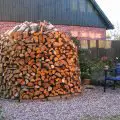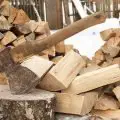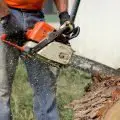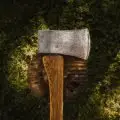If you are a woodworker, then felling trees is probably one of those jobs that you have to face often. A tree that is felled in an incorrect way may be thrown in the garbage. However, there are situations where felling trees can be more difficult than usual. And one of these cases is when felling a tree in the opposite direction is required due to a leaning tree.
A lumberjack’s job is tough as it is, since felling trees is certainly no easy task. A tree felled in the wrong direction can cause damage to property and even cause death, so it must be taken with a great cause. The job gets tougher when the tree leans towards a direction you certainly don’t want it to fall.
So, how can you cut a leaning tree in the opposite direction? Well, with the correct tools and the knowledge you’ll acquire in this article, you will be able to comfortably cut a tree in the opposite direction.
Table of Contents
- What Causes a Tree to Lean in the Opposite Direction?
- Tools Required to Cut Down a Leaning Tree
- How to Cut a Leaning Tree in the Opposite Direction Step-by-Step Guide
- Video Guide: Cutting a Tree Leaning in The Opposite Direction
- FAQs (Frequently Asked Questions)

What Causes a Tree to Lean in the Opposite Direction?
Before we get into the step-by-step guide, I think it is very important to understand why trees may lean in the opposite direction. A proper understanding of this will help you execute your task more effectively, and it may even prevent a reoccurrence.
Here are some of the most common causes of a tree leaning in the opposite direction:
- Uneven branches
- Rot or decay
- A storm
- Car accidents
Uneven Branches
When a tree has heavy branches shooting out from one end of it and lighter branches shooting out from the other, this will naturally cause the tree to start leaning. Of course, this doesn’t happen overnight, as branches take some time to grow. But in due time, the weight of the heavier branches will outweigh those on the other side and begin to cause the tree to lean.
This typically boils down to poor tree maintenance. If you do not prune the branches evenly early on, some will outgrow others and the weight of the heavier branches will drag the tree in a certain direction. The trick to preventing this from happening is by making sure all the branches are trimmed evenly when you prune.
Rot or Decay
Rotting or decaying branches and parts of the tree can also cause a tree to lean in a particular direction. Your tree will start to rot if it is infested with pests and diseases. Rotting trees tend to have a weak trunk which results in the lean. Again, this is generally due to poor tree maintenance, as pests and diseases can easily be controlled if you follow the correct preventative maintenance steps.
A Storm
Storms are completely out of our hands. They are powerful forces of nature that are strong enough, in some cases, to to rip off the roof of a building, and of course, cause your tree to lean. There is nothing we can do about a storm, as we don’t have the power to control nature’s elements.
Car Accidents
This may seem like an odd reason for a tree to lean, but it certainly happens. It is not strange that a car driven into a tree at a significant speed may cause a tree to lean. All it takes is a failed brake or a drunk driver to run into a tree. Of course, this is unlikely to happen in your yard, but it’s still a possibility.
Tools Required to Cut Down a Leaning Tree
The tools you will need to cut a tree leaning in the opposite direction are pretty much the same tools you would need to cut an upright tree. But, it’s best to quickly cover them to ensure you have everything ready before leading onto the step-by-step guide.
However, strong ropes and anchor pins may be the difference. You typically will not need these to cut an upright tree, but if your tree is leaning in an unfavorable direction, then you will certainly require them to guide the fall towards your preferred direction.
Here is a list of the tools you will need to cut a tree leaning in the opposite direction.
- A chainsaw
- An ax
- Strong rigging ropes
- A measuring tape
- A ladder
- Ground anchor pins
It’s also very important to protect yourself, so, getting adequate protective gear is strongly recommended. Some protective gear ideas include:
- Helmet
- Goggles
- Safety boots
- Hand gloves
- Ear defenders
Additional Safety Tips
Some more safety tips are being updated with your city’s tree felling regulations, just to be sure you are not breaking any laws. You may also need some assistance where the ground anchor pins are installed. The extra hands there will go a long way in helping to hold the ropes steady and guide the fall of the tree. Said helper should also be alert at all times, so they can get out of the way when the tree starts to fall.
If the tree leans towards a dangerous obstacle such as a power cable, it’s important that you DO NOT attempt to cut this yourself. In such a situation, you MUST hire the services of professionals to handle the job safely. Unless you’re adequately trained. Finally, remember to get out of the way of the tree when it begins to fall!
How to Cut a Leaning Tree in the Opposite Direction Step-by-Step Guide
It may be worth contacting some lumberjacks before starting your process to see if any are interested in buying the felled tree. This way, as soon as you finish, it won’t take long for all of the trees to be disposed of. Now, we can get into how to fell a tree that is leaning the wrong way! Follow these steps for felling a leaning tree:
- Assess the situation
- Determine the back lean
- Place ropes and ground anchor pins
- Initiate cutting
- Make the back cut
- Pull the tree
- Clear out area
Now, let’s take a look at each step in more detail!
1. Assess the Situation
The first, and very important step which is often neglected, is to assess your situation properly. It would be a massive mistake to put a chainsaw to the trunk of a tree without assessing the situation and environment first.
Make sure you properly study the angle of the lean, as well as any obstacles in the surrounding area. If the tree leans towards your house or garage, then be sure to have every person out of that building before you even think about beginning. If necessary, move your cars and every other moveable property that is nearby before you start.
After you have completely cleared out the environment, you can determine the center of gravity on the lean, and then mark out the spot where you would like to make your first cut. It may be necessary to cut off some branches if possible to reduce the weight and leverage.
2. Determine the Back Lean
The next step is to determine the back lean of the tree. Some calculations will be involved in this phase, just to ensure the tree falls in the direction you wish. Once you have determined the direction where the tree is going to fall, as well as the offset center of gravity, you are able to proceed to determine the amount of back-lean the tree will produce when it’s cut.
These measurements are very crucial, especially when you are dealing with a significantly heavy tree. You should use your measuring tape to take a measurement of the diameter of the stump. You can then use this measurement to give you the distance between the front hinge and the rear edge of the tree.
3. Place Ropes and Ground Anchor Pins
The ropes are necessary to guide the tree from the opposite direction to the direction you want it to fall. So, the next thing to do is to carefully place the ladder on the tree and climb up with the ropes. Carefully wrap the rope around the area close to the top of the tree and make a very strong and firm knot.
Now take the other end of the rope and make another knot around the ground anchor pin. Use a hammer to secure the pins into the ground. It’s very important to make sure they are firm and sturdy enough to be able to withstand the weight of the tree.
You can make as many knots on the tree as you deem necessary, as long as you use an even amount of ground anchor pins. Do not tie multiple ropes to one anchor pin. This step will ensure that when the tree is cut, it will not fall in the direction it leans towards and can instead, be pushed in the opposite direction.
4. Initiate the Cutting
Now that you have all your ropes and anchor pins in place, it’s time to get the chainsaw out. You should make the first undercut at the lower side of the tree that faces the direction where you want the tree to fall. Since the tree is leaning, the undercut should be made at a reverse 45° angle (facing upwards), and the cut should stop at the center of the tree trunk.
Now it’s time to make the second cut above the first undercut. This cut should be straight, and it must meet the endpoint of the first undercut. These two cuts, if done correctly, will form a notch, which must be removed for the tree to be able to fall smoothly.
5. Make the Back Cut
Here’s where it can get tricky since the tree is leaning. You must be sure to make the back cut about an inch above the first undercut, as this will help create the desired wedge.
However, the back cut should not meet the tip of the first two cuts. You need to give them at least an inch apart.
WARNING: If you make the back cut to a point where it meets the tip of the first two cuts, then you may no longer be able to control the fall of the tree.
You should also be prepared to move out of the way, as this is the point when the tree could fall at any second.
6. Pull the Tree
When all the cuts have been made, the tree should lose its hold and will be ready to fall, if it hasn’t started already. How to drop a leaning tree? This is the point where the extra hands will be helpful to help you give the tree a little pull, or drag, in the direction where you want the tree to fall. All it will take is a hard, sharp yank and then you should get out of the way to a safe distance.
7. Clear Out the Area
After your leaning tree has successfully fallen, hopefully in the direction you intended, you can begin clearing out the area. There will no doubt be broken branches and chips of wood all over the floor. This is where your ax may come in handy, or the chainsaw, to cut the tree up and take the pieces away with the help of a wheelbarrow.
Video Guide: Cutting a Tree Leaning in The Opposite Direction
Here are a couple of useful YouTube demonstrations on cutting down leaning tree:
FAQs (Frequently Asked Questions)
How do you cut a heavily leaning tree?
To cut a heavily leaning tree, first, you must assess the situation and determine the back lean. Then you can cut off large branches to reduce the weight and leverage before tying ropes at the top of the tree and anchoring them to the ground with anchor pins. The next step is to make a notch on the tree in the direction you want it to fall before felling a cut from the other side. As the tree is ready to fall, pull or drag it in the direction you intend.
Should I cut down a leaning tree?
If the tree is leaning more than 15% from vertical then yes, it should probably be cut down. Leaning trees are more of a hazard than those that grow normally (vertical). A sudden lean indicates breakage or weakening of roots and the tree should probably be cut down immediately.





